Cookbook #234: Sunset Cook Book for Entertaining, the Editors fo Sunset Books and Sunset Magazine, Lane Books, Menlo Park, California, 1971.
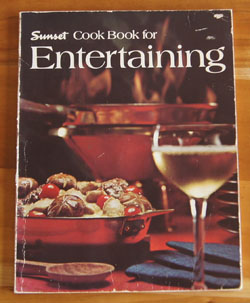 Entertaining, not my forté! I’m a bit too much of an introvert so I’ve never practiced it a lot. Sort of shy. And don’t get me wrong, I love cooking for people, but when it comes to presentation, I am lacking in ability and (desire). When company comes over (usually family), I want something delicious to serve and I don’t want diners getting full on appetizers. Save room for dessert!
Entertaining, not my forté! I’m a bit too much of an introvert so I’ve never practiced it a lot. Sort of shy. And don’t get me wrong, I love cooking for people, but when it comes to presentation, I am lacking in ability and (desire). When company comes over (usually family), I want something delicious to serve and I don’t want diners getting full on appetizers. Save room for dessert!
I always thought that Sunset Cook Book for Entertaining was all about “appetizers” and I have only rarely looked through it. I am not sure even where this book came from, and it has no markings in it as clues. I pick it up and wonder how in the world I am going to be able to cook something from this cookbook, since we are on our January low-carb eating plan.
The first chapter is, indeed, appetizers. But hmmm, I see some good ideas, and only a few bad ideas. Like, no cream cheese-sour cream dips! (bad idea). The good ideas: Marinated Mushrooms, Ginger-Minted Carrots, wine-poached scallops (Coquilles St. Jacques), Quiche Lorraine Appetizers, and Hawaiian Beef Sticks. Sunset Cook Book for Entertaining also suggests having “sit-down” appetizers, where guests sit down to a first course of these goodies. I can see making that a meal, like tapas.
Maybe this is not a cookbook to be recycled.
Next is Soups and Salads – the traditional beginning of a meal. The soup and salad recipes are all easy with a few interesting flavor twists. I like the Greens with Dilled Shrimp, largely, probably, because of our low-carbed-ness moment.
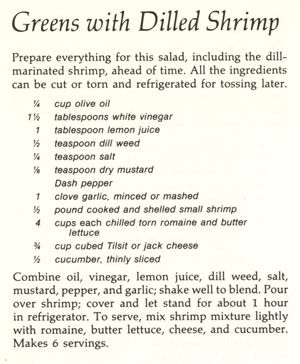 Distinctive Entrees begins: “The entree is the most important part of a meal, and the deciding factor in all the other things you serve before, with, or after.” Let’s see what they have. Most of the recipes sound good, like Beef Burgundy, Veal Veronique, and Giant Beef-Lobster Kebabs. But what I like about this chapter’s recipes is that almost each one requires very little last minute prep from the cook: “The foremost consideration in the selection of these entrees has been whether they are practical for entertaining. Nearly all of these dishes may be made partially or entirely ahead; many may be frozen.” A few of the recipes look very involved but I might find them fun: Danish Chicken and Meatblls au Gratin, for instance, calls for veal meatballs, chicken breasts, and sweetbreads, all cooked and assembled in a rich sauce ahead of time and simply heated briefly just before serving. “Pheasant-in-a-Bag” is an example of one of the more unusual dishes in this chapter. I note a recipe for Turkey Tetrazzini, one I’ve come across several times in cookbooks of this era, and one that I have explored before (Encyclopedia of Cookery, Vol. 11, All-Time Favorite Recipes, and All-Time Favorite Casserole Recipes). An easy last-minute dish is “Steak, Mushrooms, and Asparagus”, a dish I plan to make for us soon.
Distinctive Entrees begins: “The entree is the most important part of a meal, and the deciding factor in all the other things you serve before, with, or after.” Let’s see what they have. Most of the recipes sound good, like Beef Burgundy, Veal Veronique, and Giant Beef-Lobster Kebabs. But what I like about this chapter’s recipes is that almost each one requires very little last minute prep from the cook: “The foremost consideration in the selection of these entrees has been whether they are practical for entertaining. Nearly all of these dishes may be made partially or entirely ahead; many may be frozen.” A few of the recipes look very involved but I might find them fun: Danish Chicken and Meatblls au Gratin, for instance, calls for veal meatballs, chicken breasts, and sweetbreads, all cooked and assembled in a rich sauce ahead of time and simply heated briefly just before serving. “Pheasant-in-a-Bag” is an example of one of the more unusual dishes in this chapter. I note a recipe for Turkey Tetrazzini, one I’ve come across several times in cookbooks of this era, and one that I have explored before (Encyclopedia of Cookery, Vol. 11, All-Time Favorite Recipes, and All-Time Favorite Casserole Recipes). An easy last-minute dish is “Steak, Mushrooms, and Asparagus”, a dish I plan to make for us soon.
I find throughout the chapters a series of “helpful hints”. For instance, soup garnish ideas, folded napkins, flavored butter seasonings, coffees from around the world, cooking with wine, the art of the small dinner party, and a guide to serving cheeses.
Accompaniments and Side Dishes has recipes for cooked vegetables (Green Beans, Mediterranean Style), potatoes (Skillet Potatoes Anna, Pecan-Topped Sweet Potatoes), rice (Risotto), bulgur (Wheat Pilaf with Peas and Lemon), pasta (Parsley Spaghetti), and breads (Buttery Pan Rolls, Pine Nut Sticks, Honey-Pecan Cornbread Sticks, Cheesy Spoonbread).
Distinguished Desserts is next. If you’ve been paying attention, you know that I find myself drooling over most of these recipes, but am holding back on cooking them because they are calorie-laden (and carb-laden!). These tempting recipes are for tortes and souffles, puddings and pies, sherberts and glacés (one with flaming strawberry sauce), and cakes and cookies. Most of the recipes in this chapter are a little different, a little fancier than my recipes for simple chocolate cakes and such. But none are for me today. I keep reading.
Hot and Cold Drinks recipes include hot drinks (Mexican chocolate, wassail bowl), cold drinks (citrus punch, yogurt coolers, fizzes) and alcoholic drinks (sangria, glögg, milk punch with brandy, Kahlua frost).
The final chapter is Special Meals for Special Occasions.This section combines new recipes and references to previous recipes for many dinner party menus. I’d say there are tons of ideas in this chapter for “hostesses” (including a good version of Beef Fondue). Different, unusual, and tasty ideas at that. I’d like to go to one of these dinner parties! But make them? Doubt I will.
I’ve scanned in several of the menus from this chapter. They show the breadth of menus and recipes included in this book.
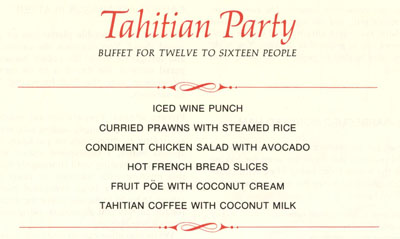

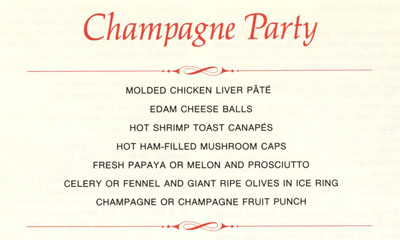
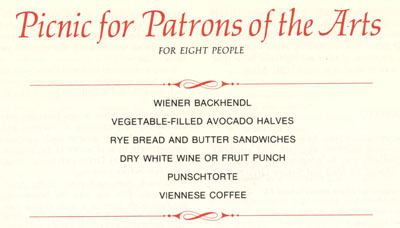
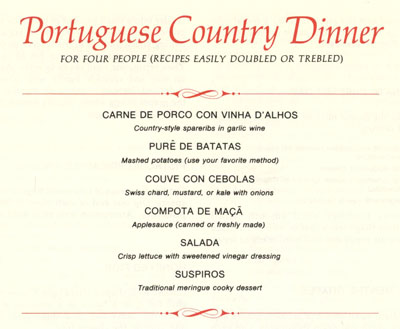
For this blog, I decide to make Steak, Mushrooms, and Asparagus from the Entrees chapter. This is a low-carb recipe, by the way! The suggested side dish carb, brown rice, is a good low-glycemic index grain choice, but I will use quinoa instead.
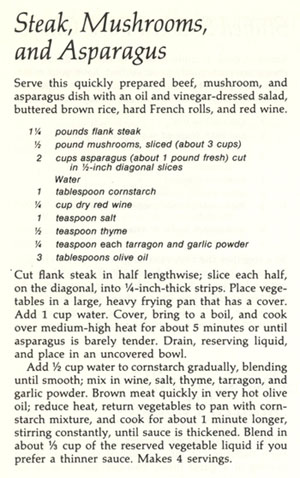 I’ve adjusted the herbs and thickening agent (cornstarch) up a bit to our own tastes, and made twice the amount of sauce.
I’ve adjusted the herbs and thickening agent (cornstarch) up a bit to our own tastes, and made twice the amount of sauce.
Steak, Mushrooms, and Asparagus
serves 2
- 12 ounces flank steak (cut one flank steak into two pieces lengthwise, use one and reserve the other for another meal)
- 1/4 pound mushrooms, sliced (about 1 1/2 cups)
- 1 cup asparagus (about 1/2 pound) cut on the diagonal into 1/2-inch pieces
- 1 tablespoon cornstarch
- 1/4 cup red wine
- 1/2 teaspoon salt
- 1/4 teaspoon tarragon
- 1/4 teaspoon garlic powder
- olive oil (about 2 tablespoons)
Cut the flank steak on the diagonal into 1/4-inch strips.
Place the mushrooms and asparagus in a frying pan. Add 3/4 cup water, bring to a boil, and cook over medium-high heat for about 5 minutes, until the asparagus is barely tender. Drain, reserving cooking liquid, and set aside.
Mix 1/2 cup water with the 1 tablespoon cornstarch, then add the wine, salt, thyme, tarragon, and garlic powder. Set aside.
Brown the meat quickly in very hot olive oil; reduce heat, return vegetables to pan, add the cornstarch mixture, and cook for about 1 minute longer, stirring constantly, until sauce is thickened. Blend in some of the reserved vegetable liquid if you prefer a thinner sauce.
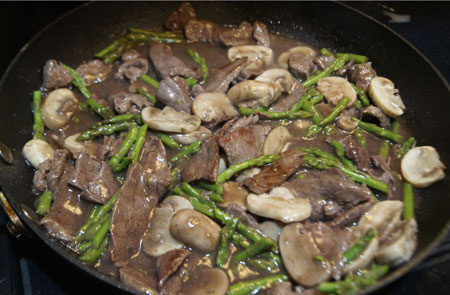 I liked this a lot, but all I got was a “pretty good” from my hubby. He is used to this type of meal with a lot of soy sauce; I, on the other hand, appreciated the subtle red wine sauce. I am not an asparagus fan, but the asparagus I found at the store was very small and young, and cut into the small pieces, I found it to be quite good.
I liked this a lot, but all I got was a “pretty good” from my hubby. He is used to this type of meal with a lot of soy sauce; I, on the other hand, appreciated the subtle red wine sauce. I am not an asparagus fan, but the asparagus I found at the store was very small and young, and cut into the small pieces, I found it to be quite good.
I also made the Dilled Shrimp with greens another day last week. It was good, but the shrimp I bought were not good – they were tiny and tough. I’m sure it would be excellent with good shrimp.
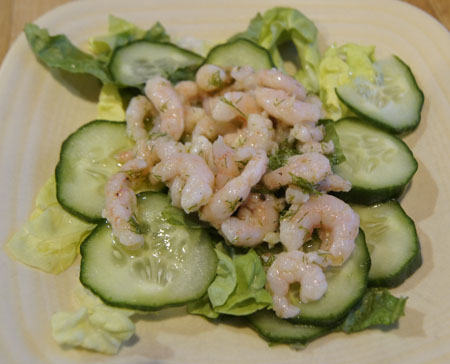 I have decided to keep this cookbook. Online, I find that it is still for sale (used) for several dollars a copy. And I found one favorable review – so I know I am not alone in appreciating this book. I have always liked the type of Southwestern cuisine that Sunset magazine promotes. Another “found” cookbook, right on my shelves!
I have decided to keep this cookbook. Online, I find that it is still for sale (used) for several dollars a copy. And I found one favorable review – so I know I am not alone in appreciating this book. I have always liked the type of Southwestern cuisine that Sunset magazine promotes. Another “found” cookbook, right on my shelves!
